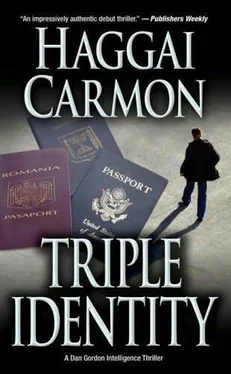Haggai Carmon - Triple Identity
Здесь есть возможность читать онлайн «Haggai Carmon - Triple Identity» весь текст электронной книги совершенно бесплатно (целиком полную версию без сокращений). В некоторых случаях можно слушать аудио, скачать через торрент в формате fb2 и присутствует краткое содержание. Жанр: Триллер, на английском языке. Описание произведения, (предисловие) а так же отзывы посетителей доступны на портале библиотеки ЛибКат.
- Название:Triple Identity
- Автор:
- Жанр:
- Год:неизвестен
- ISBN:нет данных
- Рейтинг книги:4 / 5. Голосов: 1
-
Избранное:Добавить в избранное
- Отзывы:
-
Ваша оценка:
- 80
- 1
- 2
- 3
- 4
- 5
Triple Identity: краткое содержание, описание и аннотация
Предлагаем к чтению аннотацию, описание, краткое содержание или предисловие (зависит от того, что написал сам автор книги «Triple Identity»). Если вы не нашли необходимую информацию о книге — напишите в комментариях, мы постараемся отыскать её.
Triple Identity — читать онлайн бесплатно полную книгу (весь текст) целиком
Ниже представлен текст книги, разбитый по страницам. Система сохранения места последней прочитанной страницы, позволяет с удобством читать онлайн бесплатно книгу «Triple Identity», без необходимости каждый раз заново искать на чём Вы остановились. Поставьте закладку, и сможете в любой момент перейти на страницу, на которой закончили чтение.
Интервал:
Закладка:
“OK, we're all here so let's begin,” said Eric. “We all had homework, so let's see some interim findings. Who wants to start?”
Benny turned to Shimon and nudged him. “Go on.”
Shimon grinned and went to the center of the room, where an easel was standing. He unfolded a roll of paper he was holding and put it on the easel. A large color photograph of the bank building displayed amazing clarity and detail.
Shimon stood next to the easel. “The building has three entrances.” He pointed to the main business entrance in front. “This is where the public enters during business hours. There is a side entrance for employees, which is mostly used when the main entrance is closed and at all times for the employees working on the second and third floors. I assume it's a shorter way out. It is also convenient to the elevator.”
Shimon removed the photograph and put up a second photograph taken from the rear of the building. He pointed to an entry shown at the bottom of the photograph. “The third entrance to the building is at the back and is mainly used by the superintendent of the building, by technical support staff, and for delivery of supplies and, very likely, cash and securities. A small truck can go up to the door.
“The bank building has three floors above ground. The main business floor is on the street level, the management uses the second floor, and the third floor is used for filing and storage. The building also has a small basement, mostly occupied by one big walk-in vault. There are no safe-deposit boxes for rent to customers. Metal bars protect the windows on the street level. These windows are also protected by an obsolete alarm system, the type that reacts to broken glass or vibration. I don't know yet whether that alarm system is connected to any central monitoring system in the building or elsewhere.
“The main entrance door is a heavy double door, probably made of metal sheets plated with a thin layer of copper. The lock is not a problem. However, use of the main entrance is ruled out because the bank is situated on a street that is active most hours of the day, and any forced entry from the front entrance is likely to be detected. The door used by the employees is also facing the street, though it doesn't look like a part of the bank building and may attract less attention.”
A true professional, I thought in appreciation.
“Look at the back door,” Shimon continued, pointing his finger at it. “I think it's the most suitable for a silent entry, if we opt to use a door. You'll soon see that there are other options. I did not detect any alarm systems in the hallway of either the side entry or the back entry; however, the doors themselves are protected with a rather primitive and outdated alarm system that should not cause us too much concern. I did not risk entering the second and third floors at this time.”
We listened attentively. Eric was taking notes. Benny, reading our collective thoughts asked, “So, how do we get in?”
“At this time, our best way in is through the roof,” said Shimon, pointing to the photograph. “See here, there is a tree in the backyard that extends all the way to the roof of the bank. I could climb that tree, pass onto the roof, and lower myself to a third-floor window, and from there go through the bank corridor and down the stairs to the second floor. But I'm not done with my end of the EEI, so let's not lock ourselves into that option. I'm still working on other possibilities.”
Shimon paused, as if he were waiting for approval. He then turned to me. “Dan, you were there so you'll have to draw me a floor chart showing me where Guttmacher's office is.”
“I shouldn't have a problem doing that. Besides, I think we are getting the floor plan from the city's building department. It's a public record available to anyone; you go and pull out in a central hall of archives the volume needed from a flat metal drawer, pay a small fee, and make a photocopy.”
Shimon paused, waiting for comments, and when none were made he added, “Then there's the final question: Where is the file?”
“I have the answer to that one. I went back to the bank and discovered a small vault hidden in Guttmacher's office. My guess is that's where we'll find the file.”
“And how did you arrive at that guess?” asked Benny.
“A case of a lost coat,” I said, and then gave them the details, including a description of the vault.
Shimon smiled, and Eric turned to him.
“Could you do the entry?”
“I think so, if I'm given the word. I'll need support staff, backup force, security arrangements, and some equipment.”
“If we are convinced that the file is in the vault, we still need to make a decision how to open that vault,” said Benny.
“What do you mean?” asked Eric.
“We'll have to decide whether to detonate the vault's lock and leave the scene with the door blown away or try to open it and take out the file without being noticed. Once we have the file do we remove it and leave or make copies then and there, returning the file to the vault? If the latter option is taken it increases the chances that the entire operation will remain unnoticed, but it also increases the level of danger because copying will take time. From Israel's perspective minimizing risks is very important. If something goes wrong, I don't think my government wants to be connected to a bank break-in in Europe, even if the goal is important.”
I knew what Benny was referring to. In fact, I'd wanted to say just that when Benny interrupted me. Covert operations, by definition, always had to have a built-in deniability factor. If the operation was exposed, the original operational plan must contain several levels of deniability to minimize the likelihood of positively linking the operation with the Mossad. Even when Israel releases the results of covert operations, the sources and methods utilized remain classified to protect sensitive assets.
All the Mossad's operations outside Israel are secretive and denied by the Israeli government. But there are denials and there are denials. When the Mossad kills a terrorist in his bedroom somewhere in Europe or North Africa, although Israel denies any connection Israeli officials leak the story to a foreign newspaper. This is how Israel kills two birds with one stone. The government denies any involvement so that there will be no protests by the foreign country whose sovereignty was violated by Israel. But the message is clear that Israel will pursue terrorists anywhere and under any circumstances. Then there are denials that are meant to distance Israel from any covert missions outside its borders. There are no leaks of operational details and in fact Israeli agents outside Israel spread “distracters” or “blowbacks,” false information aimed at sending investigators on a wild-goose chase. That happens in “black operations,” when Israel will stand to lose if it is connected to the operation. In the cost-benefit equation, the damage outweighs the projected gain from the exposure.
Benny continued as if he'd heard my silent explanation. “I believe that, although stealing the Iranian's nuclear materials purchasing list is important, Israel would not like to be implicated. So,” concluded Benny, “if you want my recommendation for an Israeli participation in the operation, I'd suggest that the break-in be silent, the vault secretly opened, and the file copied and returned.”
Eric sounded disturbed. “Opening a vault without explosives needs special equipment and additional professionals. It could take me up to two weeks to bring them over and orient them, and we may not have that time. Time could be of the essence; the file may be removed if we sit on our asses and wait for others to do our job.”
You could cut the tension with a knife. It was clear that Benny was controlling the meeting. He was far more senior in the Mossad than Eric was in the CIA; he was also older and more experienced. I sensed that Eric was torn by his urge to tell Benny to play second fiddle or get lost and his knowledge that he couldn't do it without Benny, at least not as fast. I also suspected that Eric had a contingency plan if the operation was exposed and people were caught. He could always spin the media to put the blame on the Mossad.
Читать дальшеИнтервал:
Закладка:
Похожие книги на «Triple Identity»
Представляем Вашему вниманию похожие книги на «Triple Identity» списком для выбора. Мы отобрали схожую по названию и смыслу литературу в надежде предоставить читателям больше вариантов отыскать новые, интересные, ещё непрочитанные произведения.
Обсуждение, отзывы о книге «Triple Identity» и просто собственные мнения читателей. Оставьте ваши комментарии, напишите, что Вы думаете о произведении, его смысле или главных героях. Укажите что конкретно понравилось, а что нет, и почему Вы так считаете.











